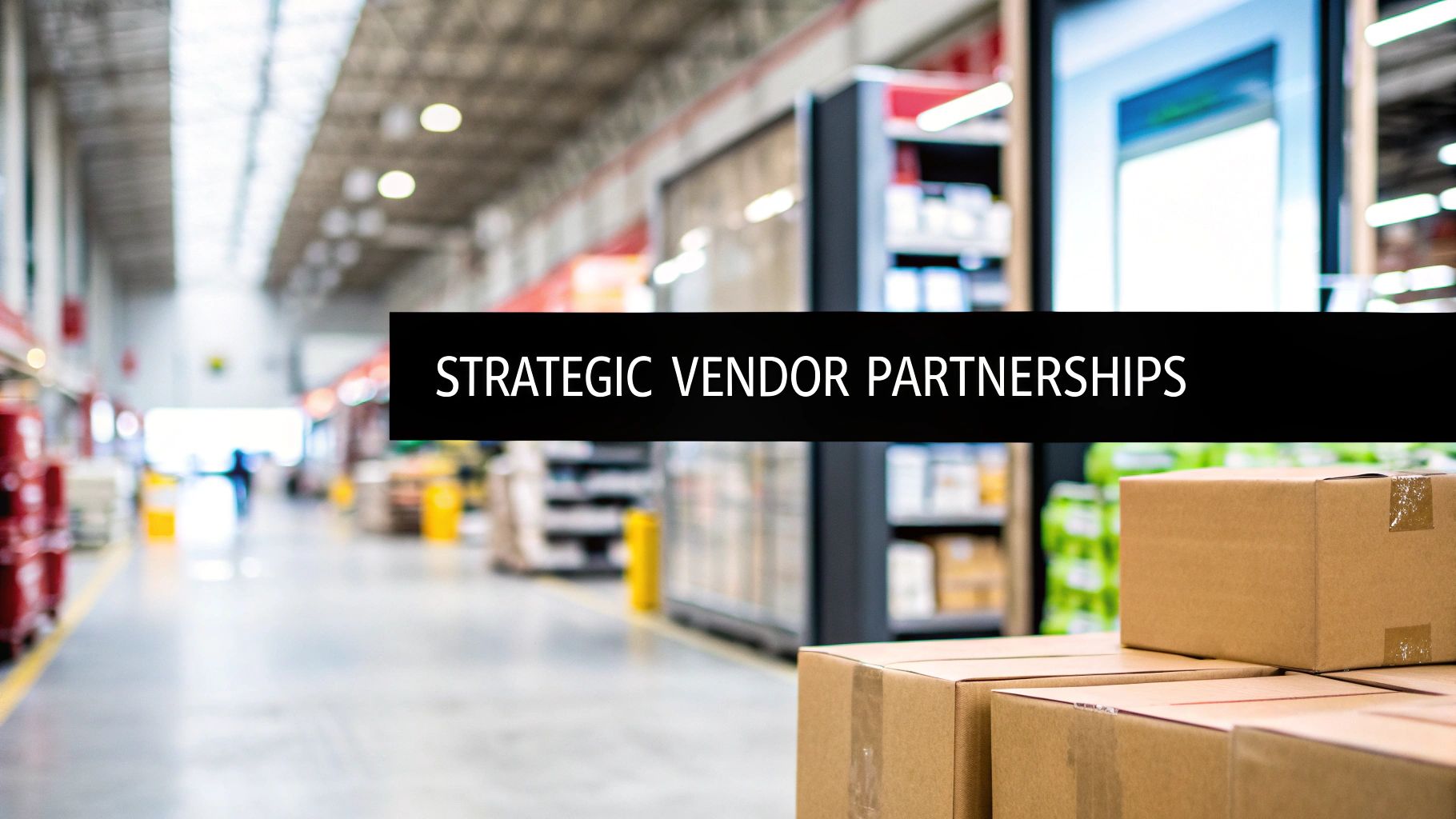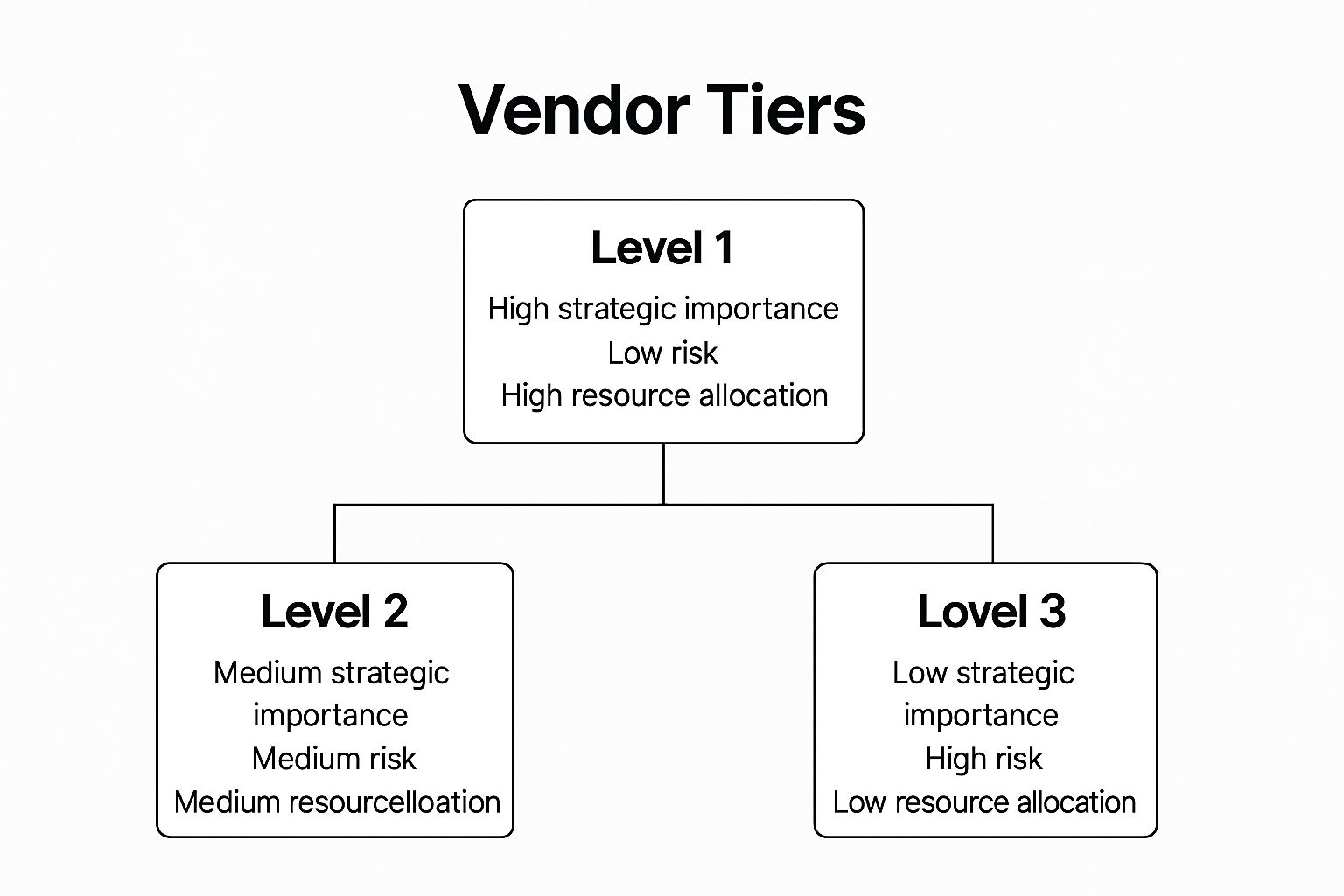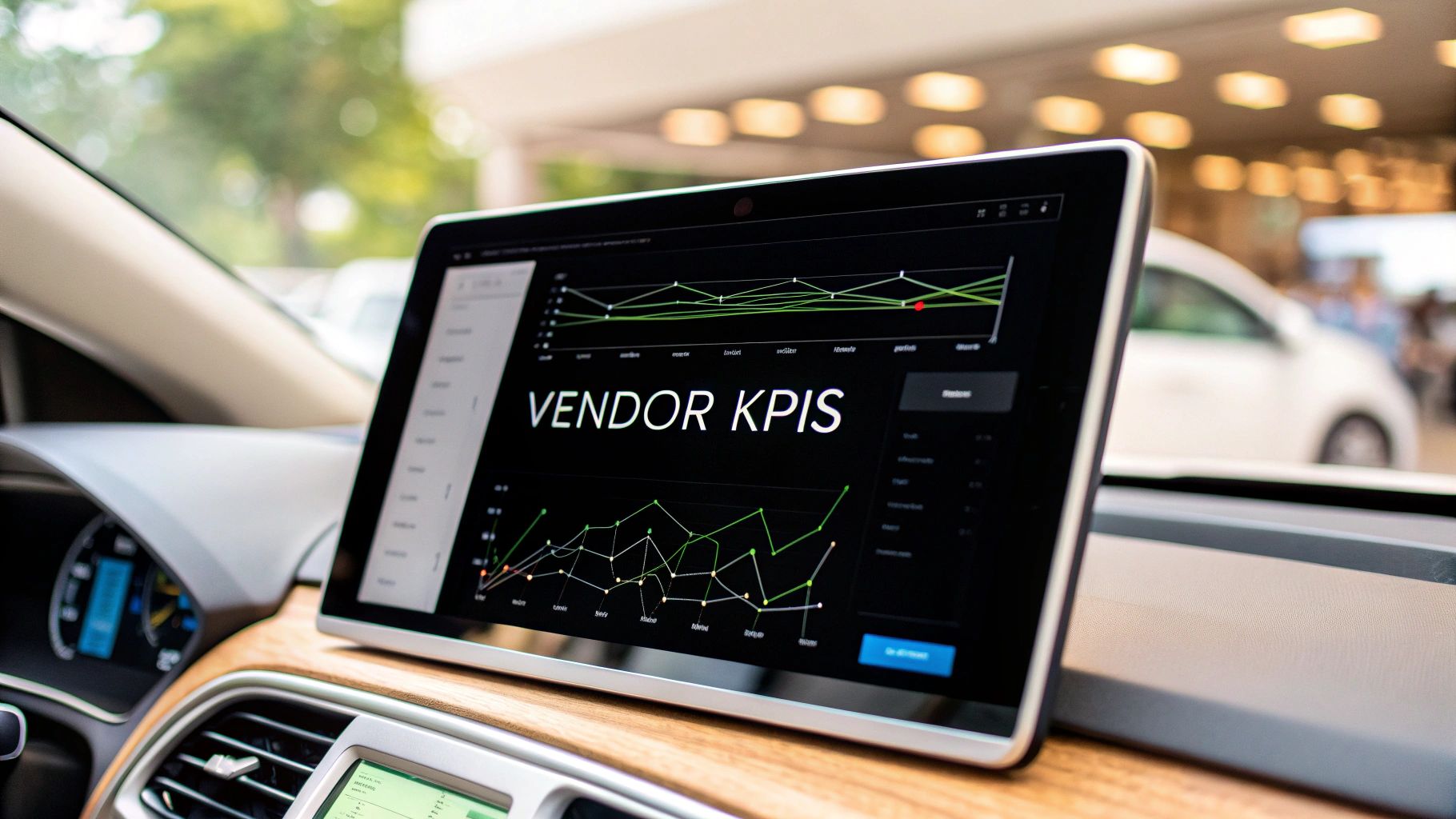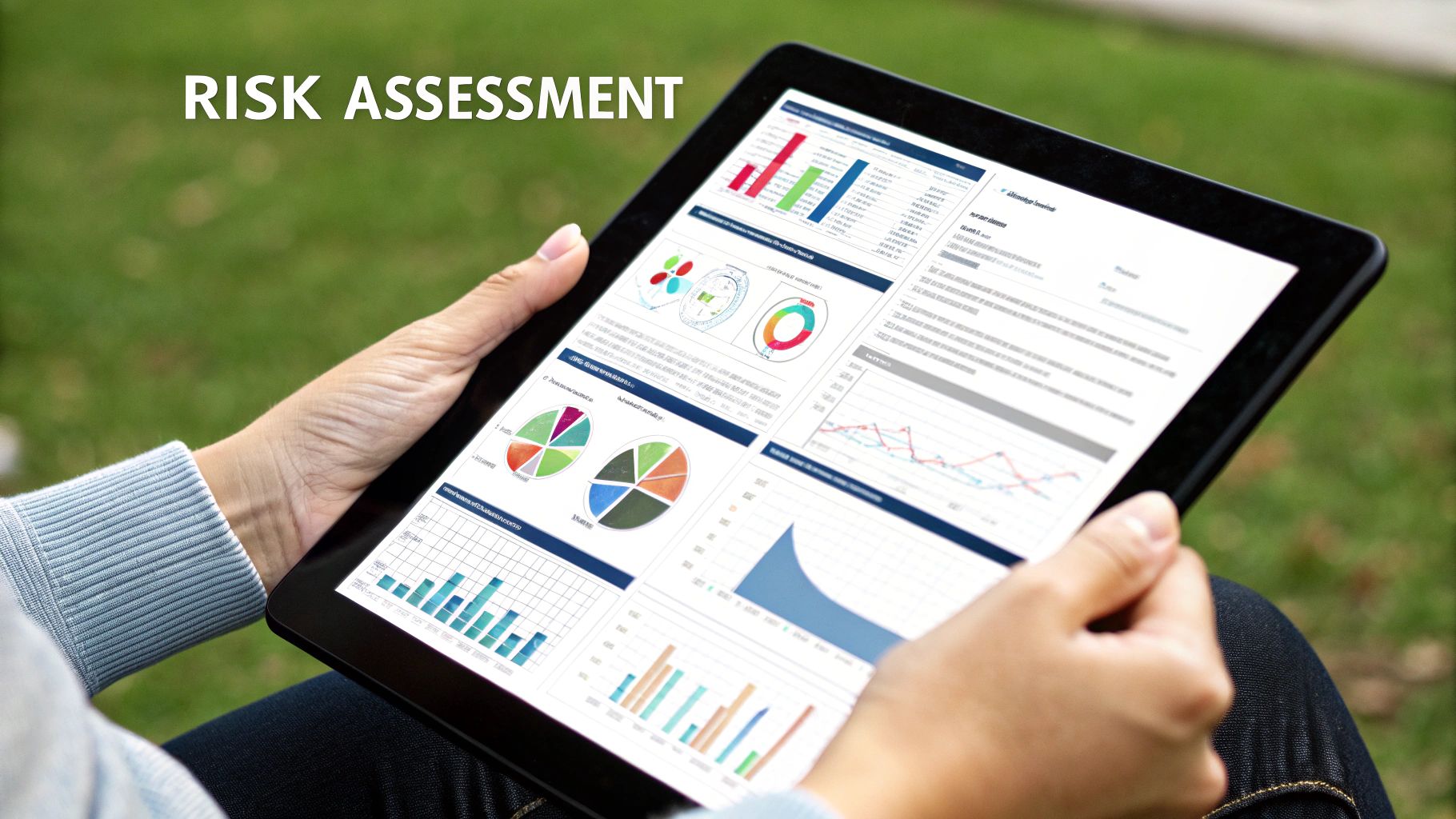Stay Updated with Everything about MDS
Thank you! Your submission has been received!
Oops! Something went wrong while submitting the form.

Chilat Doina
July 12, 2025
In the competitive world of e-commerce, the quality of your supplier relationships can be a decisive competitive advantage. Simply managing transactions is no longer enough. The most successful brands understand that their vendors are not just suppliers; they are strategic partners crucial to innovation, supply chain resilience, and long-term growth. Shifting this perspective from transactional management to strategic partnership building is fundamental for scaling your business effectively.
This guide moves beyond generic advice to provide a concrete framework of vendor relationship management best practices. We will explore actionable strategies designed specifically for e-commerce businesses aiming to optimize their supply chain and unlock new value. You'll learn how to segment vendors, establish meaningful KPIs, and implement robust governance structures. To effectively move beyond transactional hurdles and focus on these strategic partnerships, it's essential to implement streamlined financial processes. For example, adopting efficient accounts payable automation practices can significantly improve financial workflows and free up valuable resources.
By implementing the detailed best practices in this article, you will build a powerful, collaborative vendor ecosystem that directly fuels your brand’s success, enhances product quality, and improves your bottom line. Let's dive into the strategies that will transform your vendor relationships into a core business asset.
Not all vendors are created equal, and they shouldn't be managed as if they are. One of the most impactful vendor relationship management best practices is to segment suppliers into tiers based on their strategic importance to your e-commerce business. This approach, popularized by consulting firms like McKinsey & Company, allows you to allocate your most valuable resources, such as time and executive attention, where they will generate the highest return.
This systematic process involves categorizing vendors based on criteria like spend volume, business impact, and supply chain risk. By doing so, you move away from a one-size-fits-all strategy and toward a more nuanced, effective management model. For instance, a vendor supplying your flagship product's unique component is far more critical than one providing generic office supplies.
To apply this practice, you can create distinct management tiers. A common structure includes:
The infographic below illustrates how to structure these tiers based on strategic importance, risk, and resource allocation.

As the diagram shows, the highest level of resource investment should be directed toward vendors who are highly strategic and carry lower risk, maximizing partnership value.
For a deeper dive into optimizing your supply chain relationships, you can learn more about managing your e-commerce supply chain. This approach ensures your efforts are always aligned with your business's core objectives.
You can't improve what you don't measure. A core principle of effective vendor relationship management best practices is the systematic tracking of supplier performance through well-defined key performance indicators (KPIs). This data-driven approach moves your evaluations from subjective feelings to objective, actionable insights, ensuring vendors consistently meet their contractual obligations and support your business goals.

This practice, influenced by frameworks like Six Sigma and the Balanced Scorecard, involves creating a vendor scorecard or report card. It measures performance across critical dimensions such as quality, delivery, cost, and service. For example, industry giants like Dell and General Electric have long used detailed supplier scorecards to track metrics like on-time delivery, defect rates, and cost savings, holding partners accountable and driving continuous improvement.
To effectively monitor your vendors, you need to establish a clear and consistent process. This ensures that performance data is reliable and that conversations with vendors are productive.
By implementing a robust KPI monitoring system, you create a transparent and performance-oriented culture. This practice empowers you to proactively manage risks, reward top-performing suppliers, and ensure your vendor network is a powerful asset for your e-commerce growth.
Effective vendor relationship management cannot operate in a silo. A critical best practice is to establish a cross-functional governance structure that brings together stakeholders from procurement, legal, finance, operations, and key business units. This collaborative framework ensures that vendor-related decisions are made with a holistic view, aligning departmental objectives with overarching business goals.
This approach, rooted in corporate governance principles and frameworks from organizations like COSO, moves vendor management from a purely procurement function to a strategic enterprise-wide responsibility. By involving diverse perspectives, you can proactively identify risks, uncover opportunities for innovation, and ensure comprehensive oversight. For instance, a decision to switch to a cheaper logistics provider might look good to finance, but operations can provide crucial insight into potential service-level impacts.
Building a successful cross-functional team requires clear rules of engagement and shared objectives. A well-defined structure prevents confusion and fosters true collaboration.
This structure ensures that your vendor relationships are managed strategically, not just transactionally.
For more insights on building effective teams, you can learn more about creating an optimal e-commerce team structure. This will help you integrate your vendor governance council seamlessly into your broader organizational design.
Ignoring vendor-related risks is a direct threat to your business continuity. A crucial component of any vendor relationship management best practices is a proactive approach to identifying, evaluating, and mitigating potential risks. This involves a systematic process of assessing vendors for financial, operational, cybersecurity, compliance, and reputational vulnerabilities before they can cause significant disruption.
This practice, guided by frameworks like the COSO Enterprise Risk Management model, moves your organization from a reactive, crisis-management mode to a proactive, resilience-building one. For instance, a vendor's data breach or sudden financial instability can halt your operations, damage your brand, and lead to significant financial loss. A structured risk assessment process helps you anticipate these scenarios and prepare for them.

Implementing a robust risk management plan involves continuous oversight and preparation. Here’s how you can put this into practice:
By embedding risk assessment into your vendor lifecycle, you build a more resilient and secure supply chain, protecting your e-commerce business from unforeseen shocks. This strategic foresight is a hallmark of mature vendor management.
Effective vendor relationship management best practices extend far beyond purchase orders and invoices. They require a deliberate approach to communication that fosters genuine partnerships. Moving from purely transactional interactions to a collaborative model builds the trust and alignment necessary for mutual growth, innovation, and a resilient supply chain.
This strategic shift, rooted in principles from the Toyota Production System and relationship marketing, treats vendors as an extension of your own team. It involves transparency, regular dialogue, and a commitment to shared goals. For example, Intel's strategic supplier summits and Toyota's deep, collaborative supplier development programs demonstrate how this approach can drive innovation and create a significant competitive advantage.
Building these strong partnerships requires a structured communication framework. Here’s how to put it into practice:
Building strong communication channels is foundational, but it's equally important to master the art of negotiation to ensure these relationships are mutually beneficial. For more strategies on this, you can sharpen your skills by exploring how to improve negotiating with suppliers. This will help you create agreements that support long-term, collaborative success.
Beyond simply managing relationships, one of the most proactive vendor relationship management best practices is actively investing in your suppliers' growth. Vendor development is a systematic approach to improving a supplier's capabilities, processes, and overall performance through targeted programs and collaborative initiatives. This moves the relationship from a transactional exchange to a true partnership focused on mutual value creation.
This forward-thinking strategy, rooted in lean manufacturing principles, recognizes that your business is only as strong as its supply chain. By helping your vendors improve, you directly enhance your own product quality, operational efficiency, and innovation potential. For example, a supplier who learns to operate more efficiently can pass those cost savings on, while one trained in new technologies can contribute to your product development.
To effectively build vendor capabilities, you need a structured and targeted program. Focus your efforts on strategic or high-potential partners where the return on investment will be highest.
By investing in your suppliers' competencies, you are building a more resilient, innovative, and competitive supply chain that is aligned with your long-term business strategy. This practice transforms suppliers from mere order-takers into integrated partners committed to your success.
The foundation of any vendor relationship is the contract, but many businesses neglect it after the ink has dried. A crucial vendor relationship management best practice is implementing a robust Contract Lifecycle Management (CLM) process. This ensures that the terms, obligations, and value negotiated are realized throughout the partnership, from creation to renewal or termination.
CLM is a systematic approach to managing the entire lifespan of a vendor agreement. It moves beyond simple storage to active monitoring, compliance tracking, and performance management. This practice, championed by legal operations experts and procurement platforms like Ariba and Coupa, helps prevent value leakage, mitigate risk, and ensure both parties adhere to their commitments. For example, Cisco uses automated systems to monitor thousands of supplier agreements for compliance, protecting them from unforeseen risks.
Applying CLM involves establishing clear processes and often leveraging technology to streamline operations. A well-structured CLM strategy includes:
By actively managing the contract lifecycle, your e-commerce business can transform static legal documents into dynamic tools for driving performance and strengthening vendor partnerships.
First impressions matter, not just with customers, but with your vendors as well. A robust vendor onboarding and lifecycle management process sets the foundation for a productive and transparent partnership from day one. This practice involves a structured approach to bringing new vendors into your ecosystem, managing their journey with your business, and handling their eventual off-boarding professionally.
This systematic process ensures that every vendor, from qualification to separation, understands your requirements, is integrated smoothly into your operations, and remains aligned with your business goals. Neglecting this crucial phase can lead to miscommunication, compliance issues, and operational inefficiencies down the line. A formalized process, popularized by procurement experts and vendor management platforms, mitigates these risks and is a cornerstone of effective vendor relationship management best practices.
To apply this practice effectively, you need a clear, documented, and repeatable process for each stage of the vendor relationship. This framework ensures consistency and clarity for both your team and your suppliers.
A clear lifecycle approach ensures every interaction is purposeful and documented. It professionalizes your procurement function and builds a reputation as a reliable and organized partner.
For a deeper look at streamlining these processes, you can learn more about how platforms like Salesforce manage their extensive partner network through structured onboarding and certification programs.
Mastering vendor relationship management is no longer a peripheral task reserved for procurement teams; it's a core strategic function that can define an e-commerce brand's resilience, agility, and profitability. Throughout this guide, we've moved beyond surface-level advice to unpack the specific, actionable systems that transform simple supplier transactions into powerful strategic partnerships. From segmenting vendors into management tiers to implementing robust, KPI-driven performance monitoring, each practice is a building block for a more robust and competitive supply chain.
The journey from reactive supplier management to proactive partnership is built on structure and intention. By establishing a cross-functional governance team, you dismantle internal silos and ensure that vendor relationships are managed with a unified, strategic vision. Similarly, proactive risk assessment, comprehensive contract lifecycle management, and structured onboarding are not bureaucratic hurdles; they are essential frameworks that protect your business, ensure compliance, and set the stage for mutual success from day one.
To turn these insights into tangible results, focus on these critical takeaways:
The transition to a sophisticated vendor management model is a marathon, not a sprint. Begin by selecting one or two high-impact areas to focus on. Perhaps you start by conducting a thorough risk assessment of your Tier 1 vendors or by formalizing your performance review process with a clear scorecard. The key is to start now, build momentum, and incrementally integrate these practices into your daily operations.
Ultimately, mastering vendor relationship management is about creating a competitive moat around your e-commerce business. It empowers you to navigate supply chain disruptions, unlock innovation, and secure preferential treatment from the partners who are most critical to your growth. By treating your vendors as strategic allies, you don’t just manage a supply chain; you build a powerful ecosystem that propels your brand forward, ensuring you can deliver on your promises to customers, today and in the future.
Ready to learn how the world's top e-commerce entrepreneurs build and manage elite-level vendor relationships? Join Million Dollar Sellers, an exclusive mastermind community where seven, eight, and nine-figure sellers share the exact strategies they use to optimize their supply chains and scale their brands. Get direct access to proven frameworks and peer support by applying at Million Dollar Sellers today.
Join the Ecom Entrepreneur Community for Vetted 7-9 Figure Ecommerce Founders
Learn MoreYou may also like:
Learn more about our special events!
Check Events